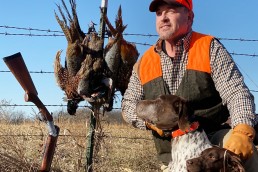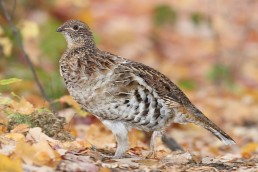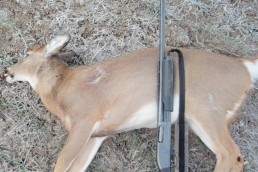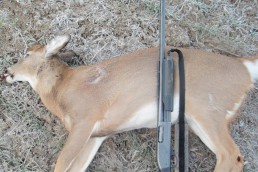A December to Remember in Iowa
SHARE THIS POST
Now parked where it all began over 150 years ago, I step out of Travis Ewing’s custom camouflaged F150. Monday morning can feel like Friday night on aging bones in the Iowa chill of December. Each breath testifies nineteen degrees of chill, to be exact. Pulling on my gloves, I hear the kennel doors crack back as two German shorthaired pointers leaped from the tailgate in anticipation. Guttural barks meant it was time to punch the timeclock.
Zoey and Diesel were off to the races, and the brisk walk behind found me as warm as I was thankful. Diesel has both the frame and engine to live up to his moniker; understandable why birds freeze up under his commanding point. On task at minutes into the hunt, flush number one was now underway. Ogling the majesty of upland flight, I ignored the safety, and chose to fight an unresponsive over/under.
“It happens,” from my guide, is something said if ages were reversed, but a good laugh is a great way to start a hunt and a healthy replacement for a third cup of java. Much action ahead forgot that blunder now behind us, and our canine couple gave everything they had, even retrieving roosters through barbed wire for just a pat on the noggin. Birds aside, the dogs are the art form and the therapy we walk the miles for.
Iowan opportunity
No secret, the two factors that determine the abundance and distribution of upland game in Iowa are weather and habitat. State-wide pheasant and quail harvests were 45% and 142% above their respective ten-year averages in 2018-19. But with over a foot of ice and snow above the yearly winter average and the sixth wettest spring in history, the Iowa DNR predicted the 2019-20 pheasant numbers dropped 17% and quail by 36%. While the southcentral and southeastern parts of Iowa tend to be quail-heavy versus the rooster-spotted northern regions, there are some hots pockets in the Hawkeye state that will fill both tags.
As a premier Orvis-Endorsed Wing-shooting Grounds, here’s where 2,500 acres of year-‘round, privately managed habitat at the Heritage 1865 proves to be a winner. Expect pristine grounds, as in the old school lay of rolling cornfields outlined in CRP grasses, with fencerows, wetland sections and forested terrains. The food and cover are there; henceforth, upland game.
You won’t hear a mention of how many birds to purchase or set here at the Heritage. With fantastic wild populations established, Ewing later supplements with monthly releases that give birds time to acclimate naturally. “As you can see, Scott, these birds are on the move and fast flyers. It’s not whether you’ll flush birds, but rather how many,” he smiles.
Sportsmen are often fooled by the notions that North and South Dakota are a purist’s dream, and surrounding states offering preserve opportunities are the disdain of upland hunting. To be clear, all states’ agencies supplement released birds to some degree on public lands. Private lands must make a living. This isn’t the golden era of the 1970s. Opportunities are what we are after, my friends, if we are going to keep this hunting legacy alive.
Heritage 1865
When Travis and Abby Ewing met in high school, they had no idea what lay ahead for them. Graduating from St. Ambrose University together, it was time to get to work.
Travis always felt his true fulfillment meant a return to the seven-generation family farm started by Samuel Ewing in 1865 with 160 acres. Diversified growth through land acquisition, ramping up a hunting resort, and now Emerald Hills Venue for special events has the younger Ewings firing on all cylinders. A true team effort, Abby handles all media, marketing, accounting and bookings. Travis tackles all day-to-day ranch affairs and guiding whitetails, pheasants, quail and turkey hunters.
A spacious, well-appointed lodge was finished in 2014, overlooking a stocked pond. Four double-bunked rooms, upstairs and downstairs seating areas, and a fully stocked bar make clients feel right at home. Hope you like whiskey. A frequent traveler, I can vouch that the table fair at Heritage 1865 is top shelf. “I like that we are a family business and want clients to feel like extended clan. I feel we offer genuine hospitality,” says Ewing.
Are you enjoying this post?
You can be among the first to get the latest info on where to go, what to use and how to use it!
While I personally hunted with Travis, rest assured any of their highly reviewed guides will execute thrilling hunts over strong pointers in a timely fashion. And while most hunters drive the hour-and-a-half down from the Des Moines airport, the Ewings can schedule a pickup and drop off run, too. “I never complain about getting up early, because I’ve been given this chance to do what I love every day,” says Travis.
Flushing it out
As for Bobwhite quail, the sequence is similar, yet altogether faster than pheasant. A fanciful 20-gauge pointed north; safety off. The pointers’ tangled rummage now at a standstill. A step past Zoe’s panting presence, and there’s an eruption of chaotic drumming as the rocketing bobs take flight. Buttstock to shoulder, it was point and pow! Regain focus, point, lead the spare bird and pow! If all goes as planned, you bite your lip, holding back a grin.
Using a Beretta over/under loaded with #6 shot, I witnessed approximately forty-five flushes over two days that broke down as follows. On day one, I took eight quail on nine flushes. One covey of six I doubled and singled on two shots. There were two coveys of three-plus, and the rest were singles. I grabbed three pheasant roosters on five flushes; one got away. Two hen flushes were off-limits, and four more birds were abandoned for my guide’s or the dogs’ safety. In all, twenty drives.
The highlight was Chef Tim Holmes preparing Quail Piccata from my harvest that night.
Day two was almost a complete turnaround, as I went eight for ten on roosters with four hens flushed. I landed two quail on six covey rises of four-to-five bobs in number. Add in five more abandoned quail flushes for safety, and that makes twenty-five drives. Those six-ounce delicacies seemed impossible to hit after downing football-sized cocks. That’s hunting.
A pleasant surprise was harvesting a melanistic pheasant. This rare pigmentation disorder causes the majority of the bird’s feathers to turn dark hues, even black, in color.
Granted, I had the pleasure of a solo hunt, due to scheduling luck, really, but you get the idea; there are plenty of birds to share with buddies. Now you just have to get here. Call Abby Ewing at Heritage 1865 and tell her you saw this article in MidWest Outdoors. MWO
Become a MidWest Outdoors Insider here!
MWO
SHARE THIS POST
Did you enjoy this post?
You can be among the first to get the latest info on where to go, what to use and how to use it!
Scott Cummings
Scott Cummings is an avid sportsman, educator and nationally published freelance outdoors writer and photographer. National Wild Turkey Federation and Wildlife Forever named him their 2013 and 2014 Conservation Educator of the Year for his work in and out of the classroom.



